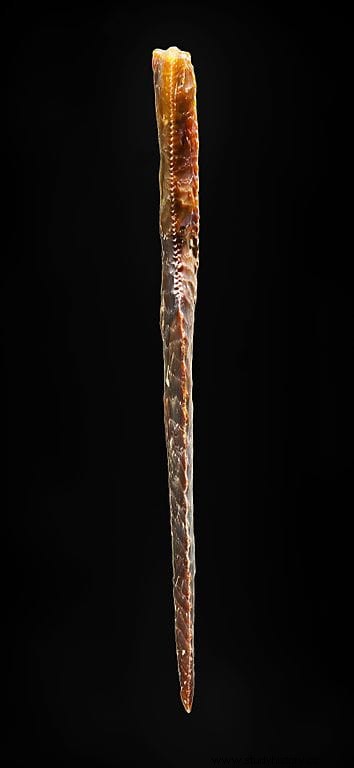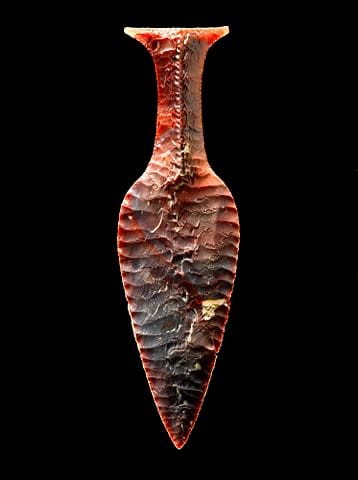In 1867 a boy playing in a field on the small Danish island of Fænø found a stone whose shape seemed interesting and curious. The property manager, who was nearby, bought the piece from the boy for a silver thaler and gave it to the owner of the estate. It turned out to be an exceptional prehistoric flint dagger.
The piece found in Fænø was exhibited in Paris in 1889, within an archaeological exhibition parallel to the Universal Exhibition of that year. That same year Sophus Müller, who was the director of the National Museum of Denmark, managed to get its owner to deposit it permanently in the institution, so that everyone could see it.
It was called Hindsgavl's Dagger, after the name of the estate where it had been found. It is 29.5 centimeters long and has an amazing blade thickness of less than 1 centimeter. It was made around 1800 BC, just as the Neolithic was ending in Scandinavia and bronze objects from Central Europe and the Mediterranean began to arrive through trade.

Humans created flint tools from the Palaeolithic more than 10,000 years ago until the end of the Neolithic, when the technical level was already very high, and just when the diffusion of metallurgy and bronze working began to spread.
The Bronze Age, which began in Asia Minor around 3300 BC, would still take approximately 1,500 years to reach present-day Denmark. By the year the Dagger of Hindsgavl is dated, the first imported bronze daggers were beginning to appear, and the flint craftsman who made it tried to imitate its shape.

That is why it has that characteristic handle in the shape of a fish tail, and that is why this type of daggers (since it is only the most outstanding and refined example) are called fish tail daggers . Because the production of these flint daggers continued in the area well into the Bronze Age. The reason is that they were much cheaper, since Scandinavia does not have important deposits of copper (the essential element of bronze), and it depended on trade.
Flint daggers were highly valued objects in Danish agricultural societies from the end of the 3rd millennium BC. While other flint objects such as axes and knives were commonly used in everyday life, daggers had another function. They were prestige items that demonstrated the status of their owner.
They were manufactured mainly in the north of the Jutland peninsula and the southeast of present-day Denmark. But not all craftsmen could make a piece like this. It was a highly specialized technique, superior to anything previously seen, and required a true master.

The striking reddish-brown color of the dagger is the result of its intentional abandonment in a bog, probably as an offering, some 3,800 years ago, and the action of tannic acid discoloring the hilt.
Today it is part of the collection of the National Museum of Denmark, and can be seen as the main motif on the 100 Danish krone note that came into circulation in 2010.
